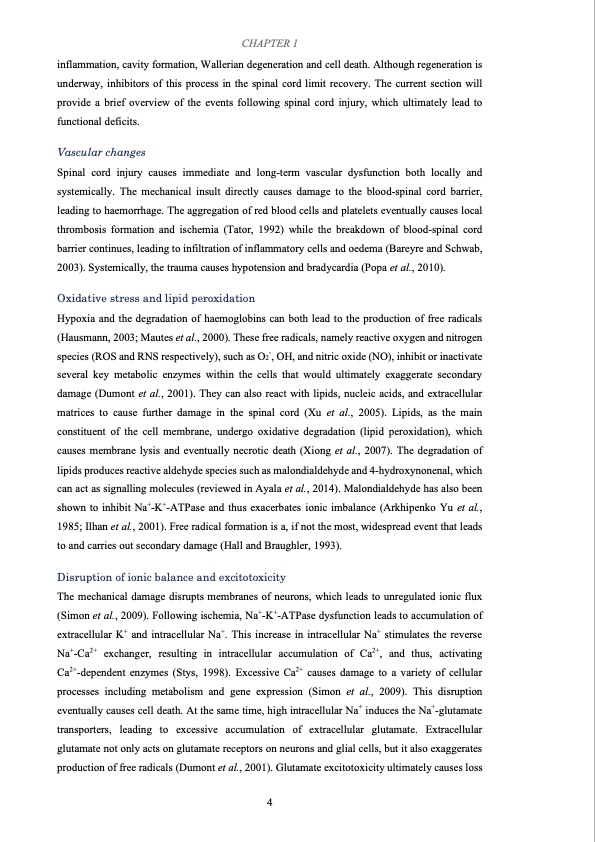
PDF Publication Title:
Text from PDF Page: 018
CHAPTER 1 inflammation, cavity formation, Wallerian degeneration and cell death. Although regeneration is underway, inhibitors of this process in the spinal cord limit recovery. The current section will provide a brief overview of the events following spinal cord injury, which ultimately lead to functional deficits. Vascular changes Spinal cord injury causes immediate and long-term vascular dysfunction both locally and systemically. The mechanical insult directly causes damage to the blood-spinal cord barrier, leading to haemorrhage. The aggregation of red blood cells and platelets eventually causes local thrombosis formation and ischemia (Tator, 1992) while the breakdown of blood-spinal cord barrier continues, leading to infiltration of inflammatory cells and oedema (Bareyre and Schwab, 2003). Systemically, the trauma causes hypotension and bradycardia (Popa et al., 2010). Oxidative stress and lipid peroxidation Hypoxia and the degradation of haemoglobins can both lead to the production of free radicals (Hausmann, 2003; Mautes et al., 2000). These free radicals, namely reactive oxygen and nitrogen species (ROS and RNS respectively), such as O2-, OH, and nitric oxide (NO), inhibit or inactivate several key metabolic enzymes within the cells that would ultimately exaggerate secondary damage (Dumont et al., 2001). They can also react with lipids, nucleic acids, and extracellular matrices to cause further damage in the spinal cord (Xu et al., 2005). Lipids, as the main constituent of the cell membrane, undergo oxidative degradation (lipid peroxidation), which causes membrane lysis and eventually necrotic death (Xiong et al., 2007). The degradation of lipids produces reactive aldehyde species such as malondialdehyde and 4-hydroxynonenal, which can act as signalling molecules (reviewed in Ayala et al., 2014). Malondialdehyde has also been shown to inhibit Na+-K+-ATPase and thus exacerbates ionic imbalance (Arkhipenko Yu et al., 1985; Ilhan et al., 2001). Free radical formation is a, if not the most, widespread event that leads to and carries out secondary damage (Hall and Braughler, 1993). Disruption of ionic balance and excitotoxicity The mechanical damage disrupts membranes of neurons, which leads to unregulated ionic flux (Simon et al., 2009). Following ischemia, Na+-K+-ATPase dysfunction leads to accumulation of extracellular K+ and intracellular Na+. This increase in intracellular Na+ stimulates the reverse Na+-Ca2+ exchanger, resulting in intracellular accumulation of Ca2+, and thus, activating Ca2+-dependent enzymes (Stys, 1998). Excessive Ca2+ causes damage to a variety of cellular processes including metabolism and gene expression (Simon et al., 2009). This disruption eventually causes cell death. At the same time, high intracellular Na+ induces the Na+-glutamate transporters, leading to excessive accumulation of extracellular glutamate. Extracellular glutamate not only acts on glutamate receptors on neurons and glial cells, but it also exaggerates production of free radicals (Dumont et al., 2001). Glutamate excitotoxicity ultimately causes loss 4PDF Image | Effects of Red Light Treatment on Spinal Cord Injury

PDF Search Title:
Effects of Red Light Treatment on Spinal Cord InjuryOriginal File Name Searched:
Thesis_Di Hu_final.pdfDIY PDF Search: Google It | Yahoo | Bing
Cruise Ship Reviews | Luxury Resort | Jet | Yacht | and Travel Tech More Info
Cruising Review Topics and Articles More Info
Software based on Filemaker for the travel industry More Info
The Burgenstock Resort: Reviews on CruisingReview website... More Info
Resort Reviews: World Class resorts... More Info
The Riffelalp Resort: Reviews on CruisingReview website... More Info
| CONTACT TEL: 608-238-6001 Email: greg@cruisingreview.com | RSS | AMP |